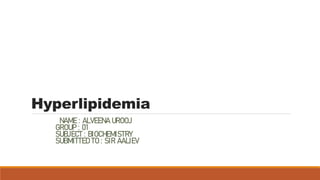
Hyperlipidemia by Alveena urooj.pptx
- 1. Hyperlipidemia NAME : ALVEENA UROOJ GROUP : 01 SUBJECT : BIOCHEMISTRY SUBMITTED TO : SIR AALIEV
- 2. Contents : ◦ Introduction Classification Mechanism of action Causes Symptoms Diagnosis and treatment Questions related
- 3. Introduction : Hyperlipidemia, also known as dyslipidemia or high cholesterol, means you have too many lipids (fats) in your blood. Your liver creates cholesterol to help you digest food and make things like hormones. But you also eat cholesterol in foods from the meat and dairy aisles. Abnormally elevated levels of fats in blood , these lipids adhere to the wall of arteries and restrict blood flow and may cause heart attack or stroke . There are 3 major lipids in our blood Cholesterol Triglyceride Phospholipids
- 5. Lipoproteins : Lipids are produced in liver . From liver lipids are not able to move to blood stream , because they are insolube in blood plasma , so liver wraps around protein in liver , resulting in new component called lipoproteins . They move to blood stream through out the body . Types of lipoproteins : VLDL LDL HDL IDL
- 7. Types : Hyperlipidemia may be further classified into : (a) Primary : They are genetic disorders characterized by distinct clinical syndromes . (b) Secondary : Due to underlying disease process usually thyroid , liver and renal disease
- 9. Mechanism of action : HMG –CoA Reductase inhibitors : HMG CoA Mevalonic acid Cholesterol Decreases LDL increases HDL and decreases triglycerides . The drugs which are used to achieve this purpose includes : Fluvastatin , lovastatin , pravastatin , rosvastation .
- 11. Nicotinic acid : To decrease VLDL production , Nicotinic acid inhibit hormone sensitive lipase . It increase VLDL and decrease LDL and triglycerides . The drug used is NIACIN . Side effects : skin flushing , hyperglycemia .
- 13. Bile acids sequestrants ( resins) : They are anion exchange resins which binds bile acids in intestiones forms the complex followed by loss of bile acids in stool and conversions of cholesterol in bile acids in blood . If there is decreased concentration of cholesterol , there will be increase in LDL receptors , increase intake of circulating LDL and decrease cholesterol LDL levels .
- 15. Fibrates : Mechanism of action : Agonists at PPAR ( Peroxisome – proliferator Activated Receptor ) Expression of genes responsible for increased activity of plasma lipoproteins lipase enzyme hydrolysis of VLDL and chylomicrons decrease TG increase clearance of LDL and HDL in liver
- 17. Causes : Smoking. Drinking a lot of alcohol. Eating foods that have a lot of saturated fats or trans fats. Sitting too much instead of being active. Being stressed. Inheriting genes that make your cholesterol levels unhealthy. Being overweight
- 18. Symptoms : Chest pain or pressure (angina) Blockage of blood vessels in brain and heart. High blood pressure. Heart attack. Stroke.
- 19. Diagnosis : Hyperlipidemia has no symptoms, so the only way to detect it is to have your doctor request a blood test called a lipid panel or a lipid profile. Your doctor will use your lipid panel to make a hyperlipidemia diagnosis. This test determines your cholesterol levels. A healthcare professional will take a sample of your blood and send it to a lab for testing, then get back to you with a full report. Your report will show your levels of: total cholesterol low-density lipoprotein (LDL) cholesterol high-density lipoprotein (HDL) cholesterol triglycerides
- 20. Treatment : Statins are the most common medicine for high cholesterol. They reduce the amount of cholesterol your body makes. Lifestyle changes Eat a heart healthy diet Seek strategies to stop smoking
- 21. Questions related : What is hyperlipidemia ? Types of lipoproteins ? Can u tell any of the cause of this disease ? Mechanism of HMG CoA reductase inhibitors ? Symptoms of hyperlipidemia ?